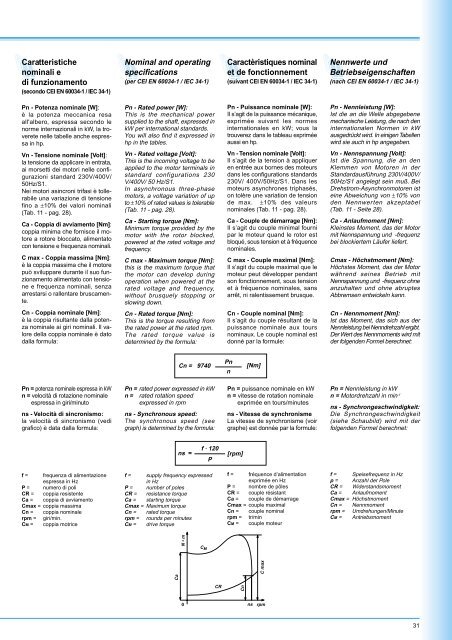NR cat. gen. 002/003 - NBC Group Ltd
NR cat. gen. 002/003 - NBC Group Ltd
NR cat. gen. 002/003 - NBC Group Ltd
You also want an ePaper? Increase the reach of your titles
YUMPU automatically turns print PDFs into web optimized ePapers that Google loves.
Caratteristiche<br />
nominali e<br />
di funzionamento<br />
(secondo CEI EN 6<strong>003</strong>4-1 / IEC 34-1)<br />
Pn - Potenza nominale [W]:<br />
è la potenza meccanica resa<br />
all'albero, espressa secondo le<br />
norme internazionali in kW, la troverete<br />
nelle tabelle anche espressa<br />
in hp.<br />
Vn - Tensione nominale [Volt]:<br />
la tensione da applicare in entrata,<br />
ai morsetti dei motori nelle configurazioni<br />
standard 230V/400V/<br />
50Hz/S1.<br />
Nei motori asincroni trifasi è tollerabile<br />
una variazione di tensione<br />
fino a ±10% dei valori nominali<br />
(Tab. 11 - pag. 28).<br />
Ca - Coppia di avviamento [Nm]:<br />
coppia minima che fornisce il motore<br />
a rotore bloc<strong>cat</strong>o, alimentato<br />
con tensione e frequenza nominali.<br />
C max - Coppia massima [Nm]:<br />
è la coppia massima che il motore<br />
può sviluppare durante il suo funzionamento<br />
alimentato con tensione<br />
e frequenza nominali, senza<br />
arrestarsi o rallentare bruscamente.<br />
Cn - Coppia nominale [Nm]:<br />
è la coppia risultante dalla potenza<br />
nominale ai giri nominali. Il valore<br />
della coppia nominale è dato<br />
dalla formula:<br />
Pn = potenza nominale espressa in kW<br />
n = velocità di rotazione nominale<br />
espressa in giri/minuto<br />
ns - Velocità di sincronismo:<br />
la velocità di sincronismo (vedi<br />
grafico) è data dalla formula:<br />
f = frequenza di alimentazione<br />
espressa in Hz<br />
P = numero di poli<br />
CR = coppia resistente<br />
Ca = coppia di avviamento<br />
Cmax = coppia massima<br />
Cn = coppia nominale<br />
rpm = giri/min.<br />
CM = coppia motrice<br />
Nominal and operating<br />
specifi<strong>cat</strong>ions<br />
(per CEI EN 6<strong>003</strong>4-1 / IEC 34-1)<br />
Pn - Rated power [W]:<br />
This is the mechanical power<br />
supplied to the shaft, expressed in<br />
kW per international standards.<br />
You will also find it expressed in<br />
hp in the tables.<br />
Vn - Rated voltage [Volt]:<br />
This is the incoming voltage to be<br />
applied to the motor terminals in<br />
standard configurations 230<br />
V/400V/ 50 Hz/S1.<br />
In asynchronous three-phase<br />
motors, a voltage variation of up<br />
to ±10% of rated values is tolerable<br />
(Tab. 11 - pag. 28).<br />
Ca - Starting torque [Nm]:<br />
Minimum torque provided by the<br />
motor with the rotor blocked,<br />
powered at the rated voltage and<br />
frequency.<br />
C max - Maximum torque [Nm]:<br />
this is the maximum torque that<br />
the motor can develop during<br />
operation when powered at the<br />
rated voltage and frequency,<br />
without brusquely stopping or<br />
slowing down.<br />
Cn - Rated torque [Nm]:<br />
This is the torque resulting from<br />
the rated power at the rated rpm.<br />
The rated torque value is<br />
determined by the formula:<br />
Cn = 9740<br />
Pn = rated power expressed in kW<br />
n = rated rotation speed<br />
expressed in rpm<br />
ns - Synchronous speed:<br />
The synchronous speed (see<br />
graph) is determined by the formula:<br />
ns =<br />
f · 120<br />
P<br />
f = supply frequency expressed<br />
in Hz<br />
P = number of poles<br />
CR = resistance torque<br />
Ca = starting torque<br />
Cmax = Maximum torque<br />
Cn = rated torque<br />
rpm = rounds per minutes<br />
CM = drive torque<br />
Ca<br />
N•m<br />
C M<br />
CR<br />
Pn - Puissance nominale [W]:<br />
Il s’agit de la puissance mécanique,<br />
exprimée suivant les normes<br />
internationales en kW; vous la<br />
trouverez dans le tableau exprimée<br />
aussi en hp.<br />
Vn - Tension nominale [Volt]:<br />
Il s’agit de la tension à appliquer<br />
en entrée aux bornes des moteurs<br />
dans les configurations standards<br />
230V/ 400V/50Hz/S1. Dans les<br />
moteurs asynchrones triphasés,<br />
on tolère une variation de tension<br />
de max. ±10% des valeurs<br />
nominales (Tab. 11 - pag. 28).<br />
Ca - Couple de démarrage [Nm]:<br />
Il s’agit du couple minimal fourni<br />
par le moteur quand le rotor est<br />
bloqué, sous tension et à fréquence<br />
nominales.<br />
C max - Couple maximal [Nm]:<br />
Il s’agit du couple maximal que le<br />
moteur peut développer pendant<br />
son fonctionnement, sous tension<br />
et à fréquence nominales, sans<br />
arrêt, ni ralentissement brusque.<br />
Cn - Couple nominal [Nm]:<br />
Il s’agit du couple résultant de la<br />
puissance nominale aux tours<br />
nominaux. Le couple nominal est<br />
donné par la formule:<br />
Pn<br />
n<br />
[rpm]<br />
[Nm]<br />
0 ns rpm<br />
Caractèristiques nominal<br />
et de fonctionnement<br />
(suivant CEI EN 6<strong>003</strong>4-1 / IEC 34-1)<br />
Pn = puissance nominale en kW<br />
n = vitesse de rotation nominale<br />
exprimée en tours/minutes<br />
ns - Vitesse de synchronisme<br />
La vitesse de synchronisme (voir<br />
graphe) est donnée par la formule:<br />
f = fréquence d’alimentation<br />
exprimée en Hz<br />
P = nombre de pôles<br />
CR = couple résistant<br />
Ca = couple de démarrage<br />
Cmax = couple maximal<br />
Cn = couple nominal<br />
rpm = tr/min<br />
CM = couple moteur<br />
Cn<br />
C max<br />
Nennwerte und<br />
Betriebsei<strong>gen</strong>schaften<br />
(nach CEI EN 6<strong>003</strong>4-1 / IEC 34-1)<br />
Pn - Nennleistung [W]:<br />
Ist die an die Welle abgegebene<br />
mechanische Leistung, die nach den<br />
internationalen Normen in kW<br />
ausgedrückt wird. In eini<strong>gen</strong> Tabellen<br />
wird sie auch in hp angegeben.<br />
Vn - Nennspannung [Volt]:<br />
Ist die Spannung, die an den<br />
Klemmen von Motoren in der<br />
Standardausführung 230V/400V/<br />
50Hz/S1 angelegt sein muß. Bei<br />
Drehstrom-Asynchronmotoren ist<br />
eine Abweichung von ±10% von<br />
den Nennwerten akzeptabel<br />
(Tab. 11 - Seite 28).<br />
Ca - Anlaufmoment [Nm]:<br />
Kleinstes Moment, das der Motor<br />
mit Nennspannung und -frequenz<br />
bei blockiertem Läufer liefert.<br />
Cmax - Höchstmoment [Nm]:<br />
Höchstes Moment, das der Motor<br />
während seines Betrieb mit<br />
Nennspannung und -frequenz ohne<br />
anzuhalten und ohne abruptes<br />
Abbremsen entwickeln kann.<br />
Cn - Nennmoment [Nm]:<br />
Ist das Moment, das sich aus der<br />
Nennleistung bei Nenndrehzahl ergibt.<br />
Der Wert des Nennmoments wird mit<br />
der fol<strong>gen</strong>den Formel berechnet:<br />
Pn = Nennleistung in kW<br />
n = Motordrehzahl in min -1<br />
ns - Synchrongeschwindigkeit:<br />
Die Synchrongeschwindigkeit<br />
(siehe Schaubild) wird mit der<br />
fol<strong>gen</strong>den Formel berechnet:<br />
f = Speisefrequenz in Hz<br />
p = Anzahl der Pole<br />
CR = Widerstandsmoment<br />
Ca = Anlaufmoment<br />
Cmax = Höchstmoment<br />
Cn = Nennmoment<br />
rpm = Umdrehun<strong>gen</strong>/Minute<br />
CM = Antriebsmoment<br />
31



